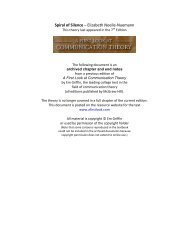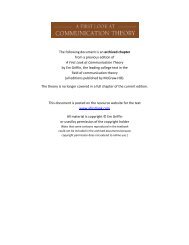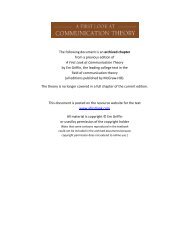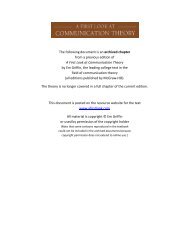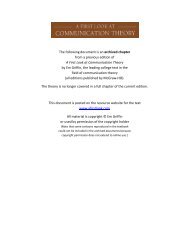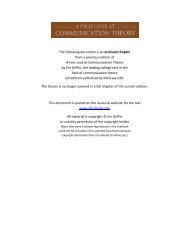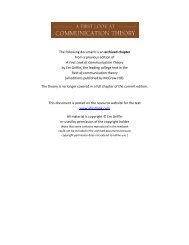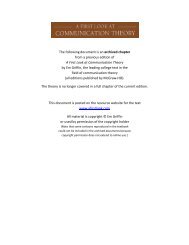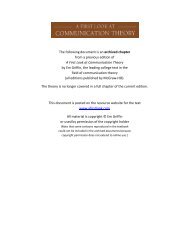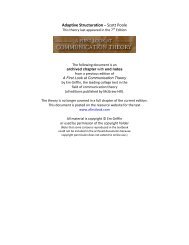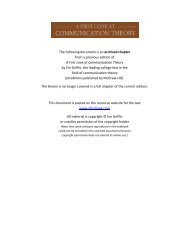Hierarchy of Needs (PDF) - A First Look at Communication Theory
Hierarchy of Needs (PDF) - A First Look at Communication Theory
Hierarchy of Needs (PDF) - A First Look at Communication Theory
You also want an ePaper? Increase the reach of your titles
YUMPU automatically turns print PDFs into web optimized ePapers that Google loves.
126 ZNTRAPERSONAL COMMUNlCATlONesteem. Note the s<strong>of</strong>tening <strong>of</strong> terminology used to describe the move up theladder. We’re driven to s<strong>at</strong>isfy the lower needs, but we’re drawn to meet thehigher ones.Maslow referred to the four lower needs as “deficiency needs” becausetheir lack cre<strong>at</strong>es a tension within us. He saw nothing wrong with the humandesire to scr<strong>at</strong>ch where we itch. As long as we can work to s<strong>at</strong>isfy thecravings, we’re moving toward growth. It’s when a repressive society or awarped individual curtails our freedom to s<strong>at</strong>isfy our needs th<strong>at</strong> we becomeill. S<strong>at</strong>isfying needs is healthy. Blocking gr<strong>at</strong>ific<strong>at</strong>ion makes us sick.The urge to fulfill needs is potent but not overpowering. Maslow thoughtth<strong>at</strong> the Freudian label instinct overst<strong>at</strong>ed the case. Maslow used the terminstinctoid to design<strong>at</strong>e a less insistent motiv<strong>at</strong>ional force. People can resist thepull <strong>of</strong> physiological, safety, love, and esteem needs, but it’s not easy.The instinctoid label also means th<strong>at</strong> these needs are universal urges andnot cre<strong>at</strong>ed by culture, as the behaviorist would claim. Although everyonehas the same set <strong>of</strong> the needs, our ways <strong>of</strong> fulfilling those needs can bedifferent. You could meet your need to belong (love and be loved) by going toa party, whereas your roomm<strong>at</strong>e might go for a quiet walk with a friend.Despite these different means <strong>of</strong> gr<strong>at</strong>ific<strong>at</strong>ion, our common desire for lovemakes us brothers or sisters under the skin.LOWER NEEDS TAKE PRIORITY UNTIL METThere is nothing unique about Maslow’s focus on physical, safety, love, andesteem needs. Other theorists include these four in their lists <strong>of</strong> basic needs.The genius <strong>of</strong> the hierarchy is its concept <strong>of</strong> prepotency. A prepotent need is theone th<strong>at</strong> has the gre<strong>at</strong>est power or influence over our actions. Maslow claimedth<strong>at</strong> everyone has a prepotent need, but the need will differ among individuals.You might be motiv<strong>at</strong>ed by a craving for love, while I may be motiv<strong>at</strong>edby a desire for esteem. Which need is prepotent for a given individual?According to Maslow, a person’s prepotent need is the lowest unmet need inthe pyramid.Not surprisingly physical drives take priority in Maslow’s system. Almostall motiv<strong>at</strong>ional theorists regard the needs for food and other physical necessitiesas powerful and primary urges. Fortun<strong>at</strong>ely for many people, thesebasic wants are usually well s<strong>at</strong>isfied. Wh<strong>at</strong> happens when there is plenty <strong>of</strong>bread and the belly is full day after day? Maslow described the shift inmotiv<strong>at</strong>ion th<strong>at</strong> occurs when survival needs are met:At once other (and higher) needs emerge, and these, r<strong>at</strong>her than physiologicalhungers, domin<strong>at</strong>e the organism. And when these in turn are s<strong>at</strong>isfied, againnew (and still higher) needs emerge, and so on. As one desire is s<strong>at</strong>isfied, anotherpops up to take its place.3Wh<strong>at</strong> follows is a brief description <strong>of</strong> the deficiency needs in the orderMaslow predicted they occur.



